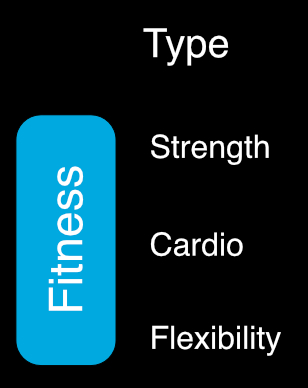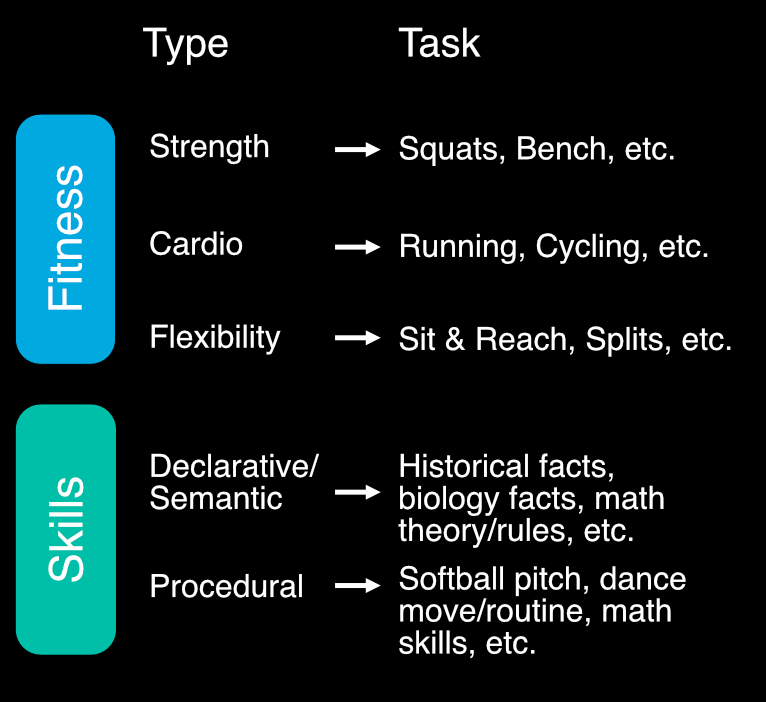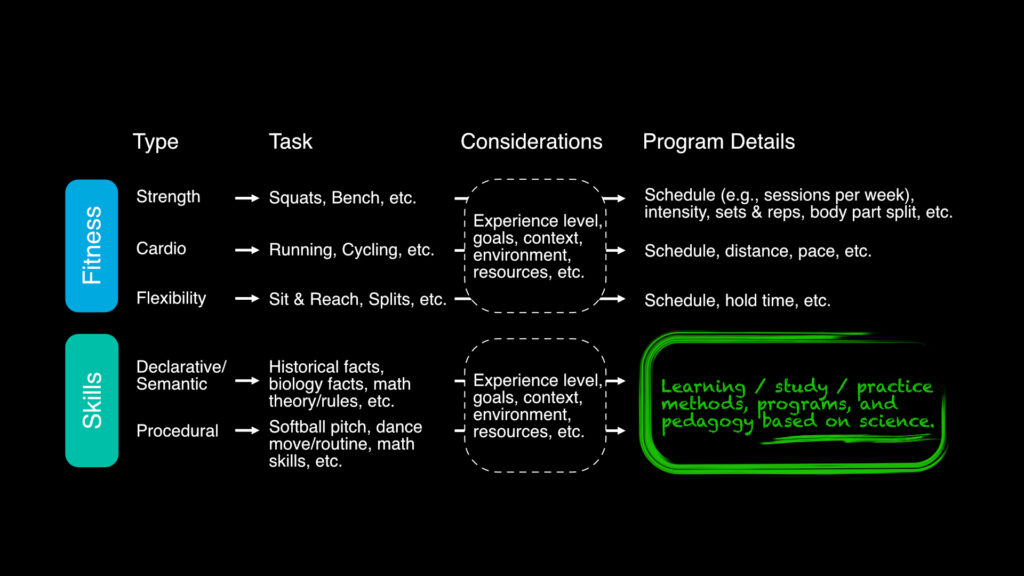The Problem
There’s no shortage of information on the internet if you want to build yourself a decent fitness program — whether you want to build muscle size and strength, train for a marathon, or whatever.
I see far less information about how to build yourself a plan to learn something.
Yes, there’s a ton of content online that will show you how to perform a skill. Youtube is filled with “how to improve your golf swing” or “how to bench press” or “how to improve your running form“. That’s not what I’m talking about.
Let me explain. With diagrams!
Let's Get on the Same Page First
Say you want to build strength. Hopefully, you’re going to choose strength training over endurance training or “cardio”. Most people understand that different types of training are better for different types of goals.
Let’s make a group called “Fitness” for these different types of trainable fitness attributes:

So given you want to build strength, you might start thinking about what to do with your body to drive a strength adaptation. Lift weights, perhaps?
Let’s add this to our diagram. Here are some tasks you can do to build different types of fitness:

OK, I know I’m not breaking new ground here. Bear with me.
Now let’s bring the topic of learning in. The analogy I’m building out here isn’t a perfect one, but I find it a useful way to think about this topic.
Say you want to learn a dance move, or some biology facts. What are you going to do to learn those things?
Well, you’re going to practice that dance move, or read some biology facts. Let’s put those under tasks in our diagram.

Let’s talk about that gap in the diagram.
Your goals in fitness are likely to be things like “get stronger” or “more endurance” and therefore are about a “type” of fitness attribute — but not always, as you could decide (more specifically) that your goal is to increase the amount of weight you can squat.
In the case of learning something, I think most of the time you’re going to be more precise: you need to learn “how photosynthesis works” to pass an exam, or you want to learn a dance move for dance class — or just because you just think it looks cool. But that doesn’t mean “types” don’t exist in the skill bucket on our diagram.
When you want to learn something, what you’re trying to “gain” — to use gain in the same way as a bodybuilder might — is a memory. So think of “type” as a type of memory on our diagram.

Optional reading: Defending "skills" on the left in this diagram.
I realize some of you nerds out there will feel that “skills” might not be the best word to use on the left here. Perhaps this diagram should say “memory” on the left, under “fitness”.
For now just consider my use of “skills” here the way you would use it on a resume: you might say you’re “skilled” in “medical device regulations”, which not only means you know a lot of facts about that topic (it could mean that) but also that you can use those facts to do something valuable (e.g., build out a regulatory strategy for a new product). To me, that’s a skill — your ability to recall the facts, synthesize them within a relevant context, and produce new work — which is what we’re really after when we want to become an expert.
That’s what I mean by skill. And in that way, it really blends together the types (semantic vs. procedural) but again, I’ll keep this blog post simple to make my point.
There are arguably many types of memories — but to keep things simple for this blog post, let’s put our examples into two types: “semantic” and “procedural”.
“Semantic” memories are facts and meanings that you learn.
“Procedural” memories are skills and habits that you learn; how to do things.
Optional: a little more about memory types.
Broadly, there are two major categories of memory: “declarative” memories (i.e., knowledge of facts and events) and “non-declarative” (everything else). “Semantic” memory is a type of declarative memory, and “procedural” memory is a type of non-declarative memory.
Here’s a simple way of remembering the differences: think of declarative memory as stuff you can easily “declare” — like stating facts, like the capital cities of countries (that’s a “semantic” memory), or what you did on your last birthday (that’s an “episodic” memory).
It doesn’t mean you can’t represent non-declarative information in words, it’s just more challenging to do. For example, an example of a procedural memory is how to ride a bicycle — I’m sure you can write it out in words, but it would take you a lot longer than just showing me that you can ride the bike. And if you can describe it but you can’t do it, then sorry, you don’t have that skill.
Here’s where it starts to get interesting. I promise.
The Details Matter
OK. Now you know what you want to train or learn.
Now you just gotta go do those tasks, right?
If you want to get strong, just go to the gym and lift weights. Correct?
Hold on a second.
Sure, you can probably just go to the gym and lift weights, somewhat randomly, with no attention paid to any sort of training program… and you’ll still get some results! In fact, if you’re a beginner you will probably have good results, for a while.
But what about 6 months later?
Your progress at the gym is probably going to slow down. And if you’re not a beginner, it may be barely noticeable.
Similarly, if you “crammed” for an exam, within 6 months you’ve probably forgotten most of it.
Again, this isn’t groundbreaking — most people understand that if you want to progress with a fitness goal, you should build a training program that is tailored to your goals. And if you want to truly learn something, you need to do a lot more than just review the material or practice it once.
If you’re serious about your goal, or you just don’t want it to take forever to see results, you’re going to want to build yourself a plan or “program”.

But wait, there’s more!
How one should build out a fitness training program depends on many factors, like goals, experience level, and more. Same goes for learning skills. We will call them “considerations”.

Unfortunately, this is where beginners often get overwhelmed and decide not to bother. They figure “I don’t even know what to do” — but like I said earlier, even without a program, you’ll get results. So don’t let my rant here discourage you.
But if you want to learn quickly, or “level up” from beginner to intermediate to advanced, and certainly if you want to achieve mastery, then you want to pay attention to program design.
And once you dive into this realm, the questions arise: How should you build your program? What actually works?
The Gap
If you want to build yourself a good training program for a fitness related goal, there’s a lot of great information online. Certainly there’s a lot of nonsense, but good information is out there.
Optional: some recommendations for fitness info.
If you want to build yourself a good program for strength training (whether your goal is muscle size or strength), there are some excellent science-based content creators out there: for example, search YouTube for Jeff Nippard and/or Mike Israetel. I think they’re great. For nutrition I think Layne Norton is good.
Would love if someone could recommend the same for cardiovascular / endurance training. I know a good amount about this topic but not enough to make a recommendation.
But here’s what I think is missing:
There is far less information out there to help someone build out a skill training program.
Again, don’t conflate this with me suggesting there isn’t a lot of good information out there on how to perform a skill properly — there are countless skill tutorials and loads of educational content out there. In fact, it’s a massive portion of internet content.
But that is very different from how you should go about training that skill, and especially how you should approach training to learn as quickly as possible, or break past plateaus and become very good at the skill.

This is the gap that exists in online content, as I see it.
If you search (e.g., Google or YouTube) for “how to learn faster” or “how to become an expert”, you’ll get a lot of mundane stuff:
- “Just do it!” type content. While I appreciate the message of stop over-thinking and “just practice” (you see this a lot in the “how to learn to code” world: “the best way to learn to code is to just code!”), the problem is that — as I mentioned earlier — it will only get you so far, and certainly isn’t the most efficient use of time. Even just a little planning can go a long way.
- “10,000 Hour Rule”. You better believe I plan to write a detailed “take down” of this common belief: that to become an expert, you need to amass 10,000 hours of “deliberate practice” (see my next point) in that skill. Quickly:
- It simply isn’t true in many cases, even for world class performers — and you might think I’m being pedantic, but these elite performers are precisely the audience for which you should get this information right.
- For most people, even if they do not intend on becoming “world class”, I believe it’s just discouraging. I believe that most people can become “good enough” and even great at most skills, in a fraction of that time. Again, I plan to elaborate on this “hot take” extensively in future content.
- “Deliberate Practice”. This refers to the point that you can’t just go through the motions and get your hours in and expect to become great. You have to actively try to get better. It is often paired with the 10,000 hour rule. That’s a fine point to make. But it also doesn’t add much — it’s like saying: “if you want to get stronger, you have to lift heavy weights”. No shit?
- Productivity content. Again, I like the message: plan your days and weeks to fit things in — obviously if you don’t make time for practice, you won’t learn the skill. But again, the fitness analogy is helpful here: great, you dedicated an hour of your day to the gym… but what should you do when you get there?
- Bro-neuroscience. There’s always some bullshit that sounds like neuroscience, like “modulating dopamine”. I can assure you it’s mostly irrelevant. I’ll commit to leveraging my neuroscience background to get to the bottom of these topics, and how they might be able to help (once you’ve dialled in the basics).
So I believe a lot of people’s understanding looks like this:

And I think it’s woefully inadequate.
Optional: What actually matters in skill learning?
When people try to get better at something, they tend to just focus on consuming content under the “Task” column of our diagram.
I am not suggesting that it’s a waste of time. In fact, it’s certainly important to pay close attention to the content (in the semantic type) or your form (in the procedural type). It’s almost certainly more important in the “skills” domain than in the fitness analogy we’ve been using. For example, perfecting your squat form (the task) for improving the weight you can lift on a squat will help, but it’s likely more important that you pay attention to your training program over time.
For skills, I would say both are important. I’m not sure if they’re equally important — let me think about that. But I’m confident that the “Program Details” column in our diagram is under appreciated in the skill learning domain.
And as for what works when it comes to “learning program” design — well, that’s an empirical question. It will depend on the type of skill, and all the considerations mentioned (and more). That’s why I think this is going to be a fairly big project — but one that I am motivated to do.
Filling the Gap
Here’s how I think our diagram should look:

And that’s what I intend to build out on this website.
To be clear: the intention is not for this site to be a place where you come to learn the skills themselves — I’ll leave that to others (though I will talk about how to seek good instruction). Instead, the focus will be on how you approach learning those skills: how to build yourself a practice schedule, skills training program, and what learning techniques to use that are proven for the type of skill you’re trying to learn.
I hope that makes sense.
Thoughts?
What do you think? Would this content be valuable to you? Others you know? Do you have any suggestions for how I should approach this project? Subjects you would like me to cover?
And of course, if you find this topic interesting and you would like to follow my work as I build out this passion project, please subscribe!

